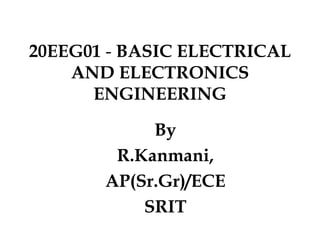This document provides an overview of the course 20EEG01 - BASIC ELECTRICAL AND ELECTRONICS ENGINEERING. The course aims to provide students with basic principles of electric circuits, electronic devices, electrical wiring, and AC/DC machines. Key topics covered include Ohm's law, Kirchhoff's laws, electric circuits, AC circuits, electrical machines, semiconductor devices, current controlled devices, and common circuit theory terms. The course outcomes are for students to understand basic concepts, domestic wiring, apply concepts to industrial applications, and analyze characteristics of electronic devices and circuits.


















